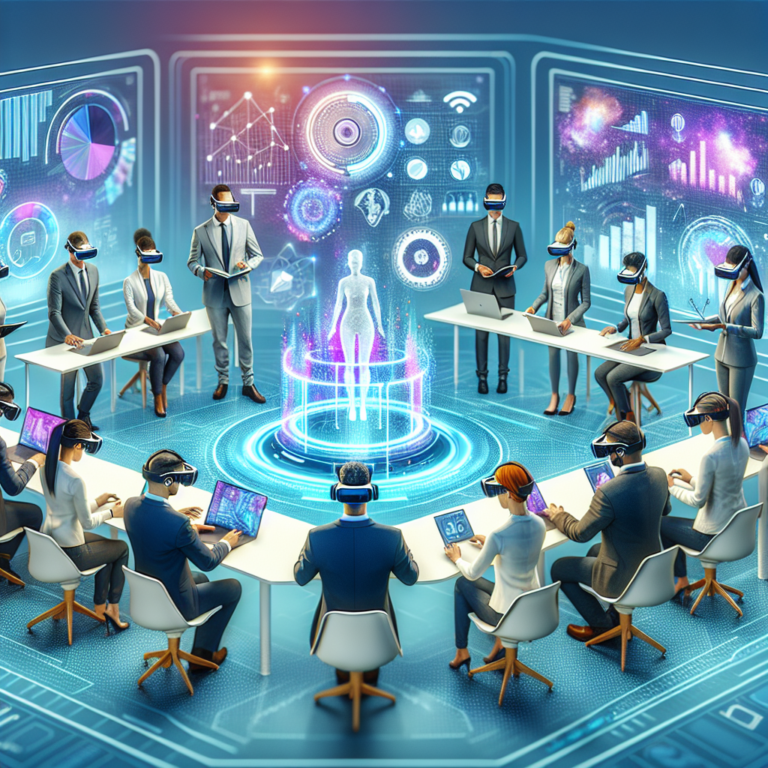Revolutionizing Remote Work: How XR Enhances Virtual Meetings and Corporate Collaboration 🌐
Introduction to XR in the Corporate Landscape
As the world becomes increasingly digital, companies are re-evaluating how they conduct meetings and collaborations. Enter Extended Reality (XR), a fusion of virtual reality (VR), augmented reality (AR), and mixed reality (MR), which is changing the game in corporate environments. Whether you are onboarding new team members, brainstorming ideas, or conducting performance reviews, XR technologies enhance engagement, boost productivity, and create a more immersive experience.
The Need for XR in Modern Business
With remote work becoming more prevalent, many organizations are struggling with traditional video conferencing tools that can feel flat and uninspired. XR addresses these limitations by offering:
- Immersive Experiences: Transporting attendees into a virtual world where they can interact and collaborate as if they were in the same room.
- Enhanced Engagement: More interactive elements help keep attendees focused and invested in the meeting.
- Improved Communication: Visual aids and real-time collaboration features foster better understanding and reduce miscommunication.
Key Benefits of XR in Virtual Meetings
Let’s dive deeper into how XR enhances virtual meetings and collaboration:
1. Creating a Sense of Presence
One of the most significant advantages of XR is the sense of presence it provides. When participants don XR headsets, they find themselves in a shared virtual space where they can “see” and “hear” their colleagues as if together in a physical meeting room. This experience promotes deeper interactions, making discussions feel more personal and effective.
2. Real-Time Collaboration Tools
XR offers various collaboration tools, enabling users to:
- Sculpt and Design: Use virtual whiteboards to brainstorm and sketch ideas in real-time.
- Simulate Environments: Visualize products, designs, or service prototypes in a 3D format.
- Share Screens: Share presentations or documents within the virtual layout, enhancing clarity and focus.
3. Increased Inclusivity
One of the promises of XR technology is its ability to enhance inclusivity. Employees from different geographical locations can participate on an equal footing, eliminating travel barriers and saving time and costs. People who require accommodations will find XR’s capabilities beneficial as features like customizable avatars and backgrounds can be made accessible to suit different needs.
4. Breaking the Ice with Gamification
Meetings can often feel like a chore, but XR introduces the element of gamification to make sessions more enjoyable. By incorporating games and interactive scenarios, teams can engage in team-building exercises and ice-breakers that foster camaraderie and lighten the mood.
Implementing XR for Corporate Collaboration
Introducing XR technology does require some planning and integration into existing systems. Here are the steps every organization should consider:
- Assess Your Needs: Identify your objectives for using XR—be it training, strategy discussions, or project presentations.
- Choose the Right Tools: Select XR software and hardware that align with your organization’s goals. Popular tools include VR meeting rooms and AR applications for collaboration.
- Train Your Team: Provide training to ensure your employees can effectively use the XR tools and leverage them for productivity.
- Gather Feedback: Regularly collect feedback from your team on the XR experience to identify areas for improvement.
The Future of XR in Corporate Collaboration
As technology continues to evolve, so will the capabilities of XR in the corporate landscape. The future might hold:
- AI Integration: Artificial intelligence could further refine how XR is used in meetings, personalizing experiences for users.
- Accessibility Enhancements: Improvements in XR could cater to all individuals, regardless of their abilities, leading to a genuinely inclusive collaboration environment.
- Widespread Adoption: As more companies recognize the benefits of XR, it could become the standard for virtual meetings.
Real-World Applications of XR in Corporate Environments
Across various industries, organizations are embracing XR technology. Here are examples of how different sectors are implementing XR effectively:
1. Tech Companies
Tech firms leverage XR for software development meetings, enabling remote teams to visualize the UI/UX designs and conduct usability testing within the virtual environment.
2. Education and Training
Schools and corporate training programs utilize XR to create immersive learning experiences. This method has proven effective in engaging learners and improving retention.
3. Healthcare
Healthcare professionals employ XR for training simulations that allow medical staff to practice surgeries or consultations in a risk-free environment.
Challenges and Considerations
While XR offers numerous benefits, organizations may face certain challenges:
- Cost: Initial investment in XR technology can be significant, although the long-term benefits may outweigh these costs.
- Technology Adoption: Employees might be resistant to change. Providing adequate training and support is crucial.
- Security Concerns: Ensuring data security in virtual environments should be a priority for all organizations adopting XR.
As you explore XR for enhancing virtual meetings and corporate collaboration, remember that successful implementation is about aligning the technology with your team’s needs and your organizational goals. With the right approach, XR can transform how businesses collaborate, paving the way for a more interactive and engaging future. 🚀




0 Comments